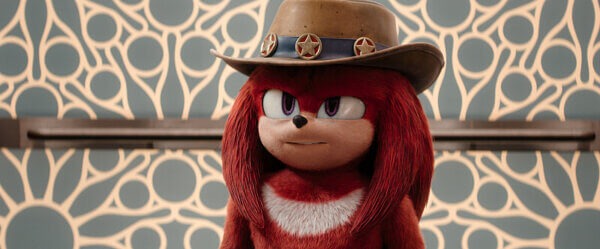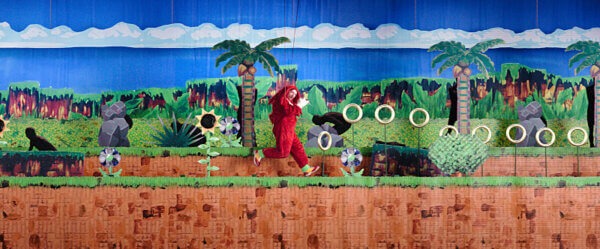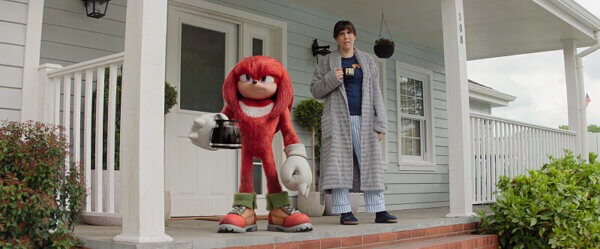Knuckles Review: “Knuckles’ presence forces the show into telling a different kind of story”

Knuckles (voiced by Idris Elba) in Knuckles, episode 5, season 1, streaming on Paramount+, 2024. Photo Credit: Paramount Pictures/Sega/Paramount+.
What do we consider animation anymore? The ubiquity of CGI in blockbuster movies means that animation is a cornerstone of the biggest films in the industry. The highest grossing movie of all time is technically an animated feature, though it’s never considered in such terms and doesn’t compete in that category in award shows. Meanwhile franchises like the Sonic the Hedgehog movies, which are predominantly live action, fall into the category of animation due to the presence of CGI characters.
What perhaps separates the Sonic movies from other live action films containing CGI characters is their prioritisation of high quality animation. Sonic is a difficult character to adapt in a live action environment, being such a stylised mascot. However, the franchise has found success with this hybrid approach, taking its ambitions to the small screen.
With TV series naturally having a smaller budget than feature films, Knuckles was always going to face the challenge of being a show focused on an inherently expensive main character. Though the quality of the animation of Idris Elba’s red echidna is a similar standard to what’s seen in Sonic the Hedgehog 2, Knuckles’ presence forces the show into telling a different kind of story.
Therefore, the focus of Knuckles shifts to Wade Wipple (Adam Pally), a human side character from the films expanded into a co-lead for the show. Having reached a breaking point with his cowardly ways, Wade enlists the help of Knuckles to teach him the ways of the warrior. But rather than gearing up for a world-threatening battle as on the big screen, Wade’s end goal is to win a bowling tournament. Meanwhile, Knuckles is the target of a kidnapping by disgruntled G.U.N agents played by Kid Cudi and Ellie Taylor, a section of the plot that plays a significant backseat role in comparison to Wade’s journey and family drama.
A consequence of the story focusing on Wade is there is little animation to discuss in comparison to the Sonic films. The six episodes almost take the form of a multi-camera half-an-hour sitcom for much of its runtime, having Knuckles as an accessory in scenes, there to absorb Wade’s abandonment issues as well as a variety of Earth delicacies along the way.
That being said, Knuckles is a very high quality accessory. His character model is designed within an inch of its life, every molecule of his fiery red spikes looking tactile and tangible. If he were animated with more slightly stilted movements, Knuckles, and any other CG characters on the show, would feel like stop-motion puppets. Perhaps that would be an elegant solution to some of the problems with the animation. Knuckles has a tendency to move through the world as if unburdened by air resistance and gravity. He’s a brute in comparison to Sonic and Tails but lacks weight in his movement due to how smooth and polished everything is. It’s hard to not daydream about Knuckles snapping between poses, giving greater gratification to both action and dialogue scenes. There’s missed potential for Knuckles’ animation to say something about his character, but maybe that creates a dissonance between him and the humans around him walking and talking normally.

Adam Pally as Wade Whipple in Knuckles, episode 4, season 1, streaming on Paramount+, 2024. Photo Credit: Paramount Pictures/Sega/Paramount+.
The large chunk of the show that is pure live action also fails to mesmerise visually. The sitcom texture which Knuckles looks to riff off traps it in that typically flat visual palette, until the show takes turns towards the surreal. One such moment sees Wade live out Knuckles’ origin story through a musical dream sequence where suddenly stagecraft, puppetry and production design burst into frame with a quality that matches the best animation on the show. A paper mache recreation of Sonic 2 (1991)’s bonus levels is the peak of the series’ inventiveness.
Also thriving throughout the six episodes is the ‘com’ aspect of this sitcom. While Knuckles is sidelined through a lot of it, the comedic chemistry between the actors is left to sizzle in delightfully silly scenes. Whether Wade is bickering with his overly confident FBI agent sister (Edi Patterson) or beefing with the series’ standout character, an perpetually intense bounty hunter and part time bowler named Jack Sinclair (Julian Barratt), the jigsaw of the show falls into place. This is a space for the Sonic team to experiment with a lighter tone and lower stakes, to take this heightened world even higher and bring out the absurdity in these human side characters.
A victim of this approach is the action, which feels like an afterthought. Much like the cinematography of the show, there are brief moments where it shines, a one-shot rotating camera fight in episode three is absolutely worth signing up for the Paramount+ 30 day trial. However, most of the action boils down to giving Knuckles something to do. When he’s being chased down by G.U.N agents or when a giant robot is thrown at him, there’s never any doubt as to how the fight will end. There’s a way for a lack of jeopardy to still feel exciting through detailed choreography, but the smoothness of all the animation inspires nothing, you just wait for the fights to end.

L-R: Knuckles (voiced by Idris Elba) and Edi Patterson as Wanda Whipple in Knuckles, episode 4, season 1, streaming on Paramount+, 2024. Photo Credit: Paramount Pictures/Sega/Paramount+.
The issue with the action is indicative of what the goals of this show are. For those who grew up with Sonic games and get a kick out of seeing these characters in this form, there’s not a tonne to get excited over. This show is purely focused on the fans who were introduced to Sonic through these movies and are invested in this iteration of the characters.
Through TV, they have an excuse to shift focus away from the characters we know and love, and build out the rest of this cinematic universe we’ll spend the next decade receiving instalments from. It’s a smart business decision but doesn’t assuage the concerns that an animation-live action hybrid approach is the wrong fit for these characters. Knuckles works, it’s easy to throw on and have fun with, but ultimately speaks to the missing potential of this whole franchise.
Knuckles premieres on Paramount+ on April 27


